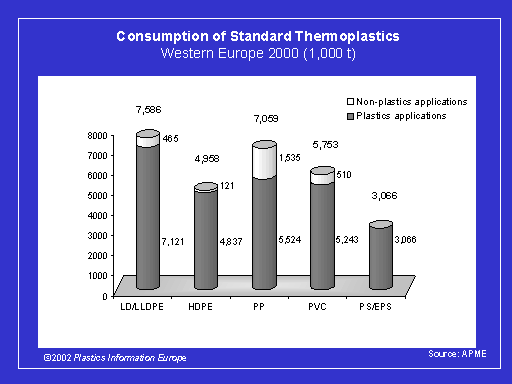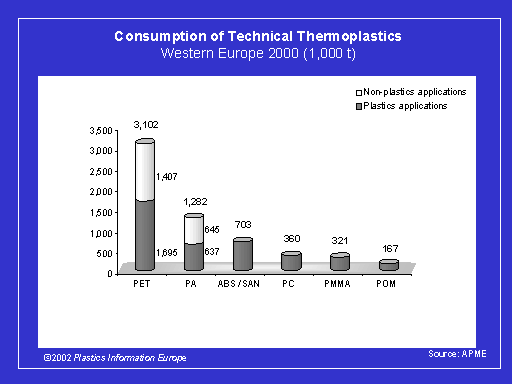WESTERN EUROPEAN PLASTICS MARKETS
APME sees “significant growth” in recycling / EuPR criticises mechanical recycling figures / E&E products with highest consumption growth / Report provides detailed statistical information
Growth in plastics recovery not only kept pace with increased consumption in 2000, but actually outstripped it, the Association of European Plastics Manufacturers in Europe (APME, B-1160 Brussels; www.apme.org) says in its report, “An analysis of plastics consumption and recovery in Western Europe 2000”, compiled for the association by TN Sofres Consulting. The report provides a number of informative statistics as well as background material on plastics consumption and waste management organised according to polymer type, application and countries.
Total consumption of polymers for all plastics applications in western Europe grew by 3% in 2000 to 36.8m tonnes, according to the figures. At the same time, the total amount of post-consumer plastics wastes collected increased 2% to 19.5m t. Some 11% more (6.9m t) was recovered, compared with 1999, while the amount landfilled or incinerated without energy recovery declined 4%. Thereby, the proportion of collectable wastes recovered rose to 36% from 33% in 1999.
APME´s impressive recovery figure of 36% for all plastics (33% in 1999) includes incineration for energy recovery as well as mechanical and feedstock recycling. If energy recovery as a means of recycling is excluded, the pan-European recycling ratio comes to only 13%.
Of the 19.5m t of post-consumer wastes collected, the lion´s share (7m t) went to energy recovery (4.4m t), followed by mechanical recycling (2.2m t) and feedstock recycling (329,000 t). The latter application, in which chemical feedstocks such as paraffin and methanol are recovered from plastics wastes to produce new petrochemical products, has been declining since 1997. One reason is that such facilities are in place only in Germany. Another is the trend toward more eco-efficient mechanical recycling processes.
EuPR makes critical comment
In the view of the European plastics recyclers´ association EuPR (B-1000 Brussels; www.eupr.org), the report gives a distorted picture of the actual recycling market. While the association agrees that the volume of post-consumer plastics wastes collected througout the EU has increased, it disagrees with the plastics producers´ statement that mechanical recycling increased by 17% in 2000 against 1999. According to EuPR, its members´ recycling capacity actually decreased during that time frame. The discrepancy lies no doubt in conflicting definitions of what constitutes recycling. EuPR said it has offered to collect its own statistics and work with APME on future recycling studies.
Denmark leads the list of western European countries in recycling, although this is due for the most part to the large percentage of energy recovery in electricity and heat generation (75.3%). At the bottom are the UK (13.1%) and Ireland (6.5%). Germany is at the top in mechanical recycling to produce new plastic products, with a rate of 29.4%. However, in the total recovery ratio it is only in fourth place, with 55.8%.
The APME study provides an interesting perspective on the individual application sectors from which the wastes derive. Agriculture had the highest recovery rate (53%), while electrical-electronic applications had the lowest (5%.). The rate for automobiles was 11%, for building and construction 10%. The largest amount of wastes going into mechanical recycling came from trade and distribution (1.07m t), followed by municipal waste collection with 643,000, agriculture with 147,000 t, automotive with 76,000 t and building / construction with 57,000 t.
Plastics Consumption in western Europe
Total consumption of thermoplastics for all applications – including non-plastics applications such as manmade fibres, and coatings – increased by 3.2% to 35.8m t, the study shows. Non-plastics applications accounted for 14% of all thermoplastics consumed in western Europe in 2000. The motor of consumption growth was PET with 11%, followed by LLDPE with 5.5% and PS with 3.8%. The largest amount of plastics consumed went into packaging applications (37.3%), followed by household products with 21.3%, building and construction with 18.9%. Electrical and electronic products accounted for only 7.3% of total thermoplastics consumption but showed the highest growth rates – of 5.2% to 2.7m t.
Slack demand for thermosets
While demand for thermosets rose by 3% on average in 2000 to 10.4m, including non-plastics applications, since 1998 it has been showing only sluggish growth. Growth in plastics applications in 2000 was more dynamic than in non-plastics uses.
• e-Service:
APME report “An analysis of plastics consumption and recovery in Western Europe in 2000 (English) as PDF document (874 KB)
Total consumption of polymers for all plastics applications in western Europe grew by 3% in 2000 to 36.8m tonnes, according to the figures. At the same time, the total amount of post-consumer plastics wastes collected increased 2% to 19.5m t. Some 11% more (6.9m t) was recovered, compared with 1999, while the amount landfilled or incinerated without energy recovery declined 4%. Thereby, the proportion of collectable wastes recovered rose to 36% from 33% in 1999.
APME´s impressive recovery figure of 36% for all plastics (33% in 1999) includes incineration for energy recovery as well as mechanical and feedstock recycling. If energy recovery as a means of recycling is excluded, the pan-European recycling ratio comes to only 13%.
Of the 19.5m t of post-consumer wastes collected, the lion´s share (7m t) went to energy recovery (4.4m t), followed by mechanical recycling (2.2m t) and feedstock recycling (329,000 t). The latter application, in which chemical feedstocks such as paraffin and methanol are recovered from plastics wastes to produce new petrochemical products, has been declining since 1997. One reason is that such facilities are in place only in Germany. Another is the trend toward more eco-efficient mechanical recycling processes.
EuPR makes critical comment
In the view of the European plastics recyclers´ association EuPR (B-1000 Brussels; www.eupr.org), the report gives a distorted picture of the actual recycling market. While the association agrees that the volume of post-consumer plastics wastes collected througout the EU has increased, it disagrees with the plastics producers´ statement that mechanical recycling increased by 17% in 2000 against 1999. According to EuPR, its members´ recycling capacity actually decreased during that time frame. The discrepancy lies no doubt in conflicting definitions of what constitutes recycling. EuPR said it has offered to collect its own statistics and work with APME on future recycling studies.
Denmark leads the list of western European countries in recycling, although this is due for the most part to the large percentage of energy recovery in electricity and heat generation (75.3%). At the bottom are the UK (13.1%) and Ireland (6.5%). Germany is at the top in mechanical recycling to produce new plastic products, with a rate of 29.4%. However, in the total recovery ratio it is only in fourth place, with 55.8%.
The APME study provides an interesting perspective on the individual application sectors from which the wastes derive. Agriculture had the highest recovery rate (53%), while electrical-electronic applications had the lowest (5%.). The rate for automobiles was 11%, for building and construction 10%. The largest amount of wastes going into mechanical recycling came from trade and distribution (1.07m t), followed by municipal waste collection with 643,000, agriculture with 147,000 t, automotive with 76,000 t and building / construction with 57,000 t.
Plastics Consumption in western Europe
Total consumption of thermoplastics for all applications – including non-plastics applications such as manmade fibres, and coatings – increased by 3.2% to 35.8m t, the study shows. Non-plastics applications accounted for 14% of all thermoplastics consumed in western Europe in 2000. The motor of consumption growth was PET with 11%, followed by LLDPE with 5.5% and PS with 3.8%. The largest amount of plastics consumed went into packaging applications (37.3%), followed by household products with 21.3%, building and construction with 18.9%. Electrical and electronic products accounted for only 7.3% of total thermoplastics consumption but showed the highest growth rates – of 5.2% to 2.7m t.
Slack demand for thermosets
While demand for thermosets rose by 3% on average in 2000 to 10.4m, including non-plastics applications, since 1998 it has been showing only sluggish growth. Growth in plastics applications in 2000 was more dynamic than in non-plastics uses.
• e-Service:
APME report “An analysis of plastics consumption and recovery in Western Europe in 2000 (English) as PDF document (874 KB)
 | |
 | |
27.06.2002 Plasteurope.com [15932]
Published on 27.06.2002
